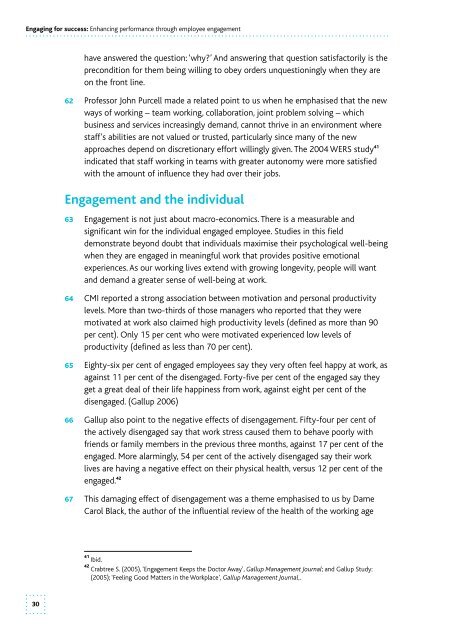3ytgeaf
3ytgeaf
3ytgeaf
You also want an ePaper? Increase the reach of your titles
YUMPU automatically turns print PDFs into web optimized ePapers that Google loves.
Engaging for success: Enhancing performance through employee engagement<br />
have answered the question: ‘why’ And answering that question satisfactorily is the<br />
precondition for them being willing to obey orders unquestioningly when they are<br />
on the front line.<br />
62 Professor John Purcell made a related point to us when he emphasised that the new<br />
ways of working – team working, collaboration, joint problem solving – which<br />
business and services increasingly demand, cannot thrive in an environment where<br />
staff’s abilities are not valued or trusted, particularly since many of the new<br />
approaches depend on discretionary effort willingly given. The 2004 WERS study 41<br />
indicated that staff working in teams with greater autonomy were more satisfied<br />
with the amount of influence they had over their jobs.<br />
Engagement and the individual<br />
63 Engagement is not just about macro-economics. There is a measurable and<br />
significant win for the individual engaged employee. Studies in this field<br />
demonstrate beyond doubt that individuals maximise their psychological well-being<br />
when they are engaged in meaningful work that provides positive emotional<br />
experiences. As our working lives extend with growing longevity, people will want<br />
and demand a greater sense of well-being at work.<br />
64 CMI reported a strong association between motivation and personal productivity<br />
levels. More than two-thirds of those managers who reported that they were<br />
motivated at work also claimed high productivity levels (defined as more than 90<br />
per cent). Only 15 per cent who were motivated experienced low levels of<br />
productivity (defined as less than 70 per cent).<br />
65 Eighty-six per cent of engaged employees say they very often feel happy at work, as<br />
against 11 per cent of the disengaged. Forty-five per cent of the engaged say they<br />
get a great deal of their life happiness from work, against eight per cent of the<br />
disengaged. (Gallup 2006)<br />
66 Gallup also point to the negative effects of disengagement. Fifty-four per cent of<br />
the actively disengaged say that work stress caused them to behave poorly with<br />
friends or family members in the previous three months, against 17 per cent of the<br />
engaged. More alarmingly, 54 per cent of the actively disengaged say their work<br />
lives are having a negative effect on their physical health, versus 12 per cent of the<br />
engaged. 42<br />
67 This damaging effect of disengagement was a theme emphasised to us by Dame<br />
Carol Black, the author of the influential review of the health of the working age<br />
41<br />
Ibid.<br />
42<br />
Crabtree S. (2005), ‘Engagement Keeps the Doctor Away’, Gallup Management Journal; and Gallup Study:<br />
(2005); ‘Feeling Good Matters in the Workplace’, Gallup Management Journal,.<br />
30


